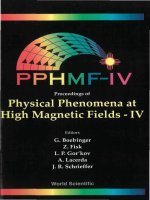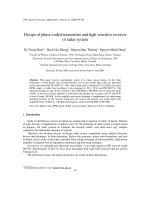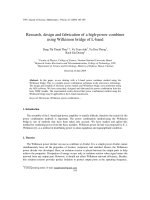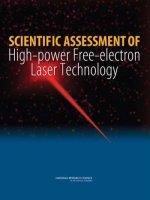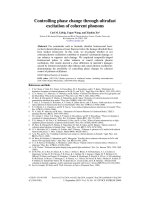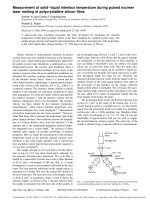phase change phenomena during high power laser materials
Bạn đang xem bản rút gọn của tài liệu. Xem và tải ngay bản đầy đủ của tài liệu tại đây (165.4 KB, 7 trang )
Materials Science and Engineering A292 (2000) 162–168
Phase change phenomena during high power laser-materials
interaction
Xianfan Xu *, Kevin H. Song
School of Mechanical Engineering, Purdue Uni6ersity, West Lafayette, IN
47907
-
1288
, USA
Abstract
This work investigates phase change phenomena due to high power pulsed laser irradiation. During high power laser heating,
the intense radiation flux from the laser is transformed to the target material and raises the temperature of the target surface
rapidly. When the laser fluence is high enough, melting and superheating of liquid are possible. At even higher laser fluences, the
superheated liquid undergoes a phase explosion that turns the liquid into a mixture of liquid and vapor. In this paper, we describe
theoretical, numerical and experimental studies of the materials’ response under nanosecond pulsed excimer laser irradiation.
Experiments are performed in a laser fluence range between 2.5 and 10 J/cm
2
(between 100 and 400 MW/cm
2
) on nickel specimens.
The velocity of the laser-evaporated vapor, absorption of the laser energy by the laser-evaporated vapor, the threshold laser
fluence for phase explosion, and the pressure and temperature at the target surface are determined. Results of these studies reveal
phase change mechanisms during high power laser interaction with metal. © 2000 Elsevier Science S.A. All rights reserved.
Keywords
:
Phase change phenomena; High power; Laser-materials interaction
www.elsevier.com/locate/msea
1. Introduction
High power excimer lasers are being used in a variety
of applications, including micro machining and pulsed
laser deposition of thin films. During these processes,
the laser beam evaporates and ionizes the target mate-
rial, creating a plasma plume above the target surface.
Understanding the energy transport process between
the laser and the target, the materials removal mecha-
nisms, and the transport process of the laser beam in
the laser-induced plasma plume is essential for con-
trolling the laser-materials interaction and optimizing
the processes.
The most important parameters needed to be under-
stood in the laser ablation process are the transient
surface temperature and the transient surface pressure.
The surface temperature determines the degrees of su-
perheating in the liquid. When the liquid is superheated
to a thermodynamic stability limit, explosive type of
phase change occurs. On the other hand, the surface
pressure determines the evaporation rate. When it is
high enough, the surface pressure causes ‘flushing’ of
the liquid out of the melt pool. This work investigates
the materials removal mechanisms based on some of
our recent experimental studies. The velocity of the
laser-evaporated plume is measured, and is used to
estimate the surface temperature and pressure using gas
dynamic relations. Optical properties of the laser-evap-
orated plume are also measured, which are needed in
the gas dynamic calculation to account for the energy
addition in the laser-evaporated plume. The pressure
due to evaporation is measured using a PVDF trans-
ducer. These time-resolved measurements are per-
formed in the laser fluence range from 2.5 to 10.5 J/cm
2
(between 100 and 400 MW/cm
2
) on nickel specimens.
Using the measured data, together with the gas dynam-
ics modeling of the laser ablated plume, the transient
temperature and pressure at the target surface during
laser ablation are obtained.
In what follows, evaporation mechanisms during
laser-metal interaction are introduced first. Details of
experiments for measuring the vapor velocity, vapor
optical properties, and the evaporation pressure are
then described, and the results are presented. A sim-
plified gas dynamic model is used to estimate the sur-
face temperature at different laser fluences. Results of
these studies will determine phase change mechanisms
* Corresponding author.
E-mail address
:
(X. Xu).
0921-5093/00/$ - see front matter © 2000 Elsevier Science S.A. All rights reserved.
PII: S0921-5093(00)00996-5
X. Xu, K.H. Song
/
Materials Science and Engineering A
292 (2000) 162– 168
163
Fig. 1. p-T diagram.
nucleation is about 0.1 s
−1
cm
−3
at the temperature
near 0.89 T
c
, where T
c
is the thermodynamic critical
temperature, but increases to 10
21
s
−1
cm
−3
at 0.91 T
c
[4]. This indicates a rapidly heated liquid could possess
considerable stability with respect to spontaneous nu-
cleation up to 0.89 T
c
, with an avalanche-like onset of
spontaneous nucleation of the entire high temperature
liquid layer at about 0.91 T
c
. At a temperature of about
0.91 T
c
, homogeneous nucleation, or explosive phase
transformation occurs, which turns the entire super-
heated liquid to a mixture and vapor leaving the surface
like an explosion.
The above description defines an upper limit for
superheating, which is shown as the spinode in Fig. 1.
The spinode temperature can also be obtained from the
thermodynamic considerations when the material loses
thermodynamic phase stability as calculated by the
second derivatives of the Gibbs’ thermodynamic poten-
tial [4]. As the temperature approaches the spinode, the
fluctuations DV and DH increase sharply, with ((p/
(V)
T
0 and ((T/(S)
p
0. A loss of thermodynamic
stability occurs, leading to phase explosion of the su-
perheated liquid.
During pulsed excimer laser heating, radiation energy
from the laser beam is transformed to thermal energy
within the radiation penetration depth, which is about
10 nm for Ni at the KrF excimer laser wavelength (248
nm). Superheating is possible since the excimer laser
pulse is short, on the order of 10
−8
s. Within this time
duration, the amount of nuclei generated by sponta-
neous nucleation is small at temperatures below 0.9 T
c
,
thus the liquid can be heated to the metastable state.
Depending on the laser fluence, the target surface can
be melted, and the liquid can successively undergo the
normal heating process, the superheating process and
the explosive phase change. Heterogeneous evaporation
occurs at the liquid surface when the laser fluence is
low. However, when the laser intensity is high enough
to induce explosive phase transformation, physical phe-
nomena associated with laser ablation are dominated
by explosive vaporization.
The theory described above was developed over two
decades ago during the study of the pulsed current
heating of metal. The intent of this work is to provide
experimental evidences of different phase change mech-
anisms during pulsed laser heating. This information is
critical for understanding of the materials removal pro-
cess induced by a pulsed laser and applications involv-
ing a pulsed laser.
3. Experimental studies
The laser used in this work is a KrF excimer laser
(l= 248 nm) with a 30 ns pulse width (FWHM). The
center, uniform portion of the excimer laser beam
during high power, pulsed excimer laser interaction
with metal.
2. Evaporation mechanisms
Under high power pulsed laser irradiation, the sur-
face of the target can be melted and evaporated, and
the temperature of the liquid can be raised above the
boiling point. To illustrate the heating process by a
pulsed laser, the p-T diagram is shown in Fig. 1 [7]. The
‘normal heating’ line indicates the heating process of
liquid metal when the temperature is below the boiling
temperature. At the boiling temperature, the liquid and
vapor phases are in equilibrium, which is shown in Fig.
1 as the intersection between the normal heating line
and the binode line. The binode line is the equilibrium
phase change relation between surface temperature and
vapor pressure calculated from the Clausius-Clapeyron
equation. When the surface temperature of a liquid is
below or at the boiling temperature, evaporation occurs
at the liquid surface, which is a type of heterogeneous
evaporation.
Under rapid heating, it is possible to heat the liquid
metal to temperatures above the boiling point. The
superheating process is represented by the ‘superheat-
ing’ line in Fig. 1. In a slow heating process, the surface
temperature-pressure relation follows the Clausius-
Clapeyron relation, i.e. the heating path follows the
binode. However, when the heating rate is fast enough,
the heating process could deviate from the binode, and
follow a superheating line shown in Fig. 1. In this case,
the liquid is superheated.
The existence of the superheated state depends on the
rate of spontaneous nucleation during heating. The rate
of spontaneous nucleation can be determined from the
Do¨ring and Volmer’s theory [5]. Using this theory, it
has been shown that the frequency of spontaneous
X. Xu, K.H. Song
/
Materials Science and Engineering A
292 (2000) 162– 168
164
Fig. 2. Setup for the measurement of transient transmissivity of the
laser-induce vapor plume.
3
.
1
. Measurement of optical properties of the laser
ablated plume
Optical properties of the laser-ablated plume will
provide information regarding to absorption of the
laser beam by the plume. The thickness of this plume
can be as thin as a few micrometers during the initial
stage of its formation, and grows to about 100 mmat
the end of the laser pulse. To detect optical properties
of such a thin layer, a special experimental set-up is
designed. Fig. 2 shows the experimental set-up for this
measurement. Details of this measurement were de-
scribed elsewhere [9]. A probing beam is split from the
excimer laser beam by a CaF
2
plate and is directed to
the center of the specimen by a dielectric mirror. The
specimen is a 5 mm-thick, freestanding nickel foil. To
measure the transmissivity of a thin plasma layer, a
circular pinhole with a diameter, d of 10–12 mmis
fabricated at the center of the specimen. The transmis-
sion of the probing beam through the pinhole is mea-
sured. If the plasma layer is thicker than dtan(u) −d,
the entire probing laser beam passes through the
plasma layer, and the path length of the probing beam
in the plasma can be determined using straight-forward
geometry calculations. Here d, d and u denote the
thickness of the nickel film, the diameter of the pinhole,
and the angle of the probing beam measured from the
normal direction of the specimen, respectively. For a 5
mm-thick film with a pinhole diameter of 10 mm, and at
the probing beam angle of 45°, transmission of the
plasma layer with a minimum thickness of 5 mm
(d tan(u)− d) can be measured.
A photo-multiplier tube (PMT) is used to capture the
transmitted light through the monochromator and
record the transient intensity of the probing beam on
an oscilloscope. Comparison between the intensity of
the probing beam with and without the plume yields
the transient transmissivity of the plume.
3
.
2
. Measurement of the 6elocity of the laser ablated
plume
The velocity of the laser-ablated plume is related to
the surface temperature and pressure, and therefore will
provide information on the ablation mechanism. Fig. 3
shows the experimental set-up for measuring the veloc-
ity of the laser-induced plasma using the optical deflec-
tion technique. The probing laser for the optical
deflection measurement is a 5 mW, He-Ne laser with a
wavelength at 633 nm. The He-Ne laser beam is fo-
cused to a 10 mm spot above the Ni target surface, and
its intensity is measured by a photodiode. The width of
the nickel specimen is about 100 mm, shorter than the
depth of focus of the probing beam. A narrow band
pass filter at the He-Ne laser wavelength is positioned
in front of the detecting photodiode to eliminate
Fig. 3. Experimental setup for measuring the velocity of the shock
front and the vapor front.
passes through a rectangular aperture (10 by 5 mm) to
produce a laser beam with a uniform intensity profile.
The rectangular laser beam is focused onto the nickel
specimen and evaporates the target surface. The laser-
evaporated surface was examined under an optical mi-
croscope. It was found that the center 90% of the
laser-irradiated area was uniform. A single 150-mm
focal length CaF
2
lens is used to focus the laser beam
on the target. The spot size is varied by translating the
lens along the optical axis. The laser fluence (energy
density per pulse) is varied through changing the spot
size at the target surface and attenuation of energy per
pulse. Energy per laser pulse at the target surface is
calibrated using an energy meter. The energy variation
is monitored through a built-in energy meter of the
excimer laser. A fast silicon photodiode sensing a split
beam from the excimer laser beam is used to trigger the
data acquisition system.
X. Xu, K.H. Song
/
Materials Science and Engineering A
292 (2000) 162– 168
165
plasma emission. The laser-induced shock wave and the
vapor front deflect the HeNe laser beam, which is
sensed by the photodiode and recorded on the oscillo-
scope. The oscilloscope, triggered by the laser pulse,
measures the time elapse between the beginning of laser
pulse and the fluctuations of the probing beam.
The distance between the probing He-Ne laser beam
and the specimen surface is adjusted by an x-y microm-
eter-stage from near zero to 500 mm. At different
distances, the arrival times of the shock front and the
vapor front are recorded. The measured distance-time
relations are the transient locations of the shock front
and the vapor front. The velocities of the shock wave
and the vapor front are calculated from the transient
locations of the shock front and the vapor front.
3
.
3
. Measurement of the laser induced shock wa6ein
the target
When the laser fluence is above the ablation
threshold, the recoil pressure due to the ablated mate-
rial leaving the target surface produces a shock wave
propagating into the target. Time resolved stress profile
induced by laser beam heating in the nickel target is
measured using a polyvinylidene fluoride (PVDF)
piezoelectric transducer [8]. The PVDF transducer is a
newly developed stress sensor. It presents several ad-
vantages including high time resolution ( 1 ns), large
measurement range (0.1 bar to 10 Mbar), and large
signal output. In addition, the PVDF transducer is
highly reproducible under recurrent shock loading,
which is often lacked in conventional piezoelectric film
shock sensors. Under shock loading, the PVDF trans-
ducer delivers a voltage V(t) proportional to the stress
difference between the two surfaces of the PVDF trans-
ducer foil [1]:
V(t)= [s
f
(t)− s
b
(t)]/l (1)
where s
f
(t) and s
b
(t) are, respectively, the shock his-
tory at the front and the back face of the transducer.
Fig. 4 shows the detailed assembly of the target and
PVDF transducer. The target is a 242 mm-thick nickel
foil (99.95% purity). Before taking data at a laser
fluence, the target surface is pre-treated using multiple
laser pulses at that laser fluence. Thin adhesive resin
(Teflon, Polytetrafluoroethylene), of which shock
impedance is matched to PVDF, holds the target to the
PVDF transducer. A 25.5 mm-thick Kel-F (polychloro-
trifluoroethylene) buffer, whose shock impedance is
also matched to PVDF, is used to mount the PVDF
transducer and is fitted into an aluminum canister. The
canister is 1 inch in diameter and 2 inches long. The
PVDF transducer is connected via a BNC cable to an
oscilloscope, which is set to the 50 V terminal load
resistance for fast data acquisition.
The excimer laser fluence is varied from 0.7 to 6
J/cm
2
. Higher fluences are not obtained in this experi-
ment, since the laser spot size has to be kept larger than
the size of the PVDF transducer, which is about 1 ×1
mm. The stress profile in the nickel target is obtained
from the measured stress profile in the PVDF trans-
ducer using the shock impedance mismatch method
with the known Hugoniot equations of state of nickel
and the PVDF material [8].
3
.
4
. Experimental results
Fig. 5 shows the velocity of the laser-evaporated
plume as a function of the laser fluence. These are
averaged velocity values within the laser pulse width.
The experiment showed that the velocity of the plume
front decayed slightly ( 10%) within the laser pulse
width. The time-averaged velocity increases with the
laser fluence increase, from 2000 m/s at the lowest
fluence to 9000 m/s at the highest fluence. However,
the increase of velocity is not monotonous; the velocity
increases slightly when the laser fluence is low. A
sudden jump of the velocity is seen at the laser fluence
of about 4.2 J/cm
2
. Between 5.2 and 9 J/cm
2
, the
velocity is almost a constant.
Fig. 4. Detailed target and PVDF transducer assembly.
Fig. 5. Velocity of the laser-evaporated plume.
X. Xu, K.H. Song
/
Materials Science and Engineering A
292 (2000) 162– 168
166
Fig. 6. Transient transmissivity of the laser-evaporated plume.
Fig. 6 shows the transient transmissivity of the plume
at different laser fluences. The transmissivity remains at
‘1’ for the first several nanoseconds, which corresponds
to the period before generation of the plume. Trans-
missivity starts to decrease at an earlier time at higher
laser fluences since evaporation occurs earlier at higher
fluences. It can be seen that the plume generation time
obtained in this experiment matches with that measured
by the optical deflection technique during the velocity
measurement. For certain laser intensity, the trans-
missivity of the plume decreases with time. The varia-
tion of transmissivity with laser intensity also shows
three regions: transmissivity is almost identical for the
laser fluences between 5.2 and 9 J/cm
2
. This laser
fluence range corresponds to the same range in which
the velocity of the plume changes little with the laser
fluence, i.e. extinction of the laser beam in the plume
does not vary with the laser intensity in the medium
fluence region.
The transmission data also indicate that the explosive
phase change occurs at laser fluences above 5.2 J/cm
2
.
Extinction of the laser beam is determined by the cross
section of the energized atoms, which in turn is deter-
mined by the temperature of the plume. The tempera-
tures of the evaporant in the medium fluence range are
all about the same since the temperatures at the surface
are all about 0.9 T
c
. Thus, transmission of the plume
stays at a constant value. At the highest laser fluence,
transmissivity decreases from that of the middle fluence
range, indicating the increase of absorption of laser
light by the plume.
All the experimental results consistently show that
laser ablation is due to heterogeneous evaporation
when the laser fluence is below 5.2 J/cm
2
, and explosive
phase change dominates the evaporation process when
the laser fluence is higher than the 5.2 J/cm
2
threshold
value. Measurements of scattering intensity of the laser
beam by the laser ablated plume and heat transfer
modeling also indicate a transition from normal surface
evaporation to the explosive phase change at a laser
fluence around 5.2 J/cm
2
[10].
Measured peak pressures in the target due to laser
evaporation are shown in Fig. 7. The peak pressure
increases almost linearly with increasing laser fluence,
with a variation between 17 bar to 760 bar when the
laser fluence varies from 1 to 6 J/cm
2
.
4. Gas dynamics analysis of the laser-induced plume
The flow of the laser-evaporated vapor is described
according to the model developed by Knight [2]. When
the laser fluence is higher than the ablation threshold
but less than the threshold for explosive phase change,
the flow process is depicted in Fig. 8a. The laser-evapo-
rated vapor leaves the target surface with a half
Fig. 7. Peak pressure in the nickel target.
The variation of the velocity increase with the laser
fluence indicates that different laser ablation mecha-
nisms occur in the laser fluence range used in the
experiment. The velocity of the plume is determined by
the pressure and the temperature at the target surface.
The constant velocity in the medium fluence region
indicates that the surface temperature is not affected by
the increase of the laser fluence in the medium fluence
region. Such a constant surface temperature can be
explained as a result of explosive evaporation. As dis-
cussed earlier, the maximum surface temperature dur-
ing explosive phase transformation is about 0.9 T
c
, the
spinodal temperature. Once the laser fluence is high
enough to raise the surface temperature to the spinode,
further increase of the laser fluence would not raise the
surface temperature. On the other hand, in the low
fluence region, the velocity increases over 50%. There-
fore, the surface temperature increases with the laser
fluence increase; heterogeneous vaporization occurs at
the surface. At the highest laser fluence, the velocity of
the plume is higher than that of the middle region. This
could be due to a higher absorption rate of the laser
energy by the plume, as shown in the transmission
measurement (Fig. 6). Absorption of laser energy by
the plume further raises the temperature of the plume
and increases the plume velocity.
X. Xu, K.H. Song
/
Materials Science and Engineering A
292 (2000) 162– 168
167
Maxwellian distribution. Collisions among vapor estab-
lish thermodynamic equilibrium in a layer called the
Knudsen layer. From the exit of the Knudsen layer, the
vapor experiences an expansion, compressing the air
ahead of the vapor at the contact front. The com-
pressed air propagates into the ambient air, forming a
shock wave.
When the laser fluence is higher than the threshold
for explosive phase change, the superheated liquid turns
into a mixture of liquid and vapor propagating into the
air as shown in Fig. 8b. The exact detail in the liquid/
vapor mixture is complicate, and is not discussed in this
work. The mixture also forms a contact front with the
air, and the compressed air propagates into the ambi-
ent, forming a shock.
4
.
1
. Gas dynamics model for surface e6aporation
Based on the model described above, it is possible to
relate the measured velocity of the shock wave and the
absorption coefficient of the plume to the temperature
and pressure at the surface. Therefore, the measured
data described before can be used to estimate the
surface conditions. Procedures of relating the measured
vapor velocity to the surface parameters are described
as follows.
The velocity of the shock wave is related to the
pressure and temperature behind the shock, p
ca
, T
ca
,by
the Hugoniot equation [3] as:
p
ca
p
amb
=2
g
air
g
air
+1
n
· M
sh
2
−
g
air
−1
g
air
+1
n
(2a)
T
ca
T
amb
=
(2 · g
air
· M
sh
2
−(g
air
−1))·((g
air
−1) · M
sh
2
+2)
((g
air
+1) · M
aa
)
2
(2b)
The velocity of the shock is embedded in the Mach
number of the shock, M
sh
· g
air
=1.4 is the ratio of
specific heats of air.
It is assumed that the pressure, temperature and the
velocity are uniform in the compressed air, therefore, at
the contact front, the pressure, temperature, and the
velocity of Ni vapor, p
cf
, T
cf
, and 6
cf
, are the same as
those of the compressed air. The relations between the
temperature and pressure at the contact front and at
the exit of the Knudsen layer, T
KL
and p
KL
, are:
c
p
· T
cf
+0.56
cf
2
+P
abs
=c
p
· T
KL
+0.56
KL
2
(3a)
p
cf
+r
cf
· 6
cf
2
=p
KL
+r
KL
. 6
KL
2
(3b)
where c
p
is the specific heat of nickel vapor, P
abs
is the
absorbed laser power by the plume, and r is the
density. The conservation equations of mass, momen-
tum and energy are used to establish the relationship
between the thermodynamic properties at the target
surface and at the exit of the Knudsen layer. For the
laser fluence used in this work, it has been shown that
the Mach number at the exit of the Knudsen layer is
one [6]. In this case, the following relations apply:
T
KL
=0.669T
sur
(4a)
p
KL
=0.375p
evap
(4b)
Using Eqs. (2)– (4), along with the measured shock
velocity and the absorption coefficient of the laser
power by the plume, the temperature at the target
surface, T
sur
, and the evaporation recoil pressure, p
evap
,
can be estimated.
4
.
2
. Results of the gas dynamics calculation
The calculated surface temperature is shown in Fig.
9. Note that, although the temperature is calculated for
the entire laser fluence range used, the computational
method is only applicable to surface evaporation; com-
putations of the surface temperature during phase ex-
plosion are not attempted. It is seen that the surface
temperature at the laser fluence of 2.5 J/cm
2
is about
5700 K, above the normal boiling point but lower than
the critical temperature of nickel, 7810 K. At the laser
fluence of 2.9 J/cm
2
, the surface temperature reaches
7766 K. At the laser fluence of 4.2 J/cm
2
, the surface
temperature is about 9600 K, exceeding the critical
value. However, it should be noted that the above
computations carry a large uncertainty due to various
assumptions and simplifications used in the calculation,
including steady-state flow, constant materials proper-
Fig. 8. One-dimensional gas dynamic models: (a) surface evaporation
(b) explosive phase change.
Fig. 9. Surface temperature calculated by the gas dynamics model.
X. Xu, K.H. Song
/
Materials Science and Engineering A
292 (2000) 162– 168
168
ties, and neglecting dissociation of air. Therefore, from
these calculations, it is not likely to determine the
surface temperature accurately. On the other hand,
when the laser fluence is above 5 J/cm
2
, the calculated
temperature is more than five times higher than the
critical temperature, which would not come from inac-
curacies in the computational model. Since the liquid
surface can not process such a high temperature, it is
concluded again, from the gas dynamics calculations
that phase explosive must have occurred at laser
fluences higher than 5 J/cm
2
.
Calculations show that, at the laser fluence of 2.5
J/cm
2
the calculated pressure is 300 bars, which is close
to the measured value (Fig. 7). The calculated evapora-
tion pressures are 700 and 818 bars at 2.9 and 4.2
J/cm
2
, while the measured values are about 380 and 500
bars, respectively. Again, exact matching between the
measured and the calculated pressures are not expected,
due to the assumptions and simplifications used in the
calculation.
5. Conclusions
Pulsed laser ablation at different laser fluences was
studied experimentally. Time-resolved measurements
were performed to determine the velocity of the laser-
induced plume, transmission (absorption) of the laser
beam in the plume, and the evaporation recoil pressure
in the laser fluence range between 2.5 and 10.5 J/cm
2
.
The measured velocity and absorptivity of the plume
were used in a gas dynamics calculation to estimate the
surface temperature and pressure. Results of different
experiments and calculations consistently showed that,
surface evaporation occurred when the laser fluence
was below 4 J/cm
2
. When the laser fluence was higher
than 5 J/cm
2
, evaporation was an explosive type phase
change.
Acknowledgements
Support by the National Science Foundation under
grant number CTS-9624890 is gratefully acknowledged.
References
[1] M. Boustie, S. Couturier, J.P. Romain, D. Zagouri, H. Simon-
net, Laser Particle Beams 14 (2) (1996) 171–179.
[2] C.J. Knight, AIAA J. 17 (1979) 519 – 523.
[3] H.W. Liepmann, Roshko, A., Wiley, New York, 1973.
[4] M.M. Martynyuk, Russian J. Phys. Chem. 57 (1983) 494–501.
[5] V.P. Skripov, Wiley, New York, 1974.
[6] K.H. Song, X. Xu, Appl. Phys. A 65 (1997) 477 – 485.
[7] K.H. Song, X. Xu, Appl. Surface Sci. 127–129 (1998a) 111–116.
[8] K.H. Song, X. Xu, Proc. 1998 ASME Int. Mech. Eng. Congress
Exposition, HTD-Vol. 361-4 (1998b) 79–86.
[9] X. Xu, K.H. Song, J. Heat Transfer 119 (1997) 502 – 508.
[10] X. Xu, G. Chen, K.H. Song, Inter. J. Heat Mass Transfer 42
(1999) 1371–1382.
.


